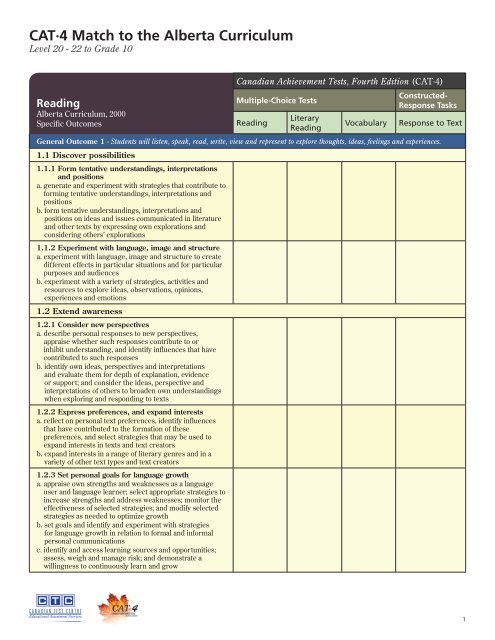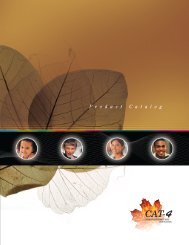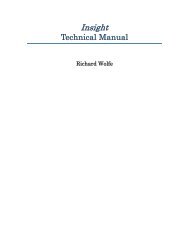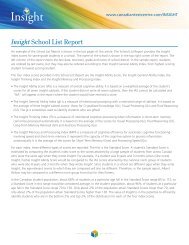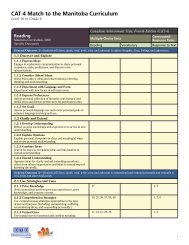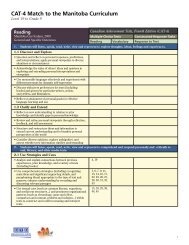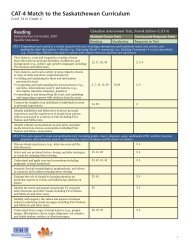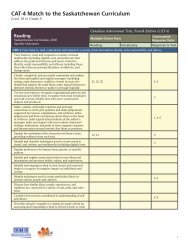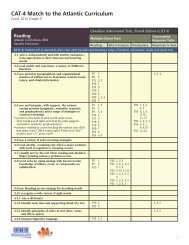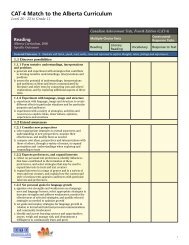Grade 10 - Canadian Test Centre
Grade 10 - Canadian Test Centre
Grade 10 - Canadian Test Centre
You also want an ePaper? Increase the reach of your titles
YUMPU automatically turns print PDFs into web optimized ePapers that Google loves.
CAT∙4 Match to the Alberta Curriculum<br />
Level 20 - 22 to <strong>Grade</strong> <strong>10</strong><br />
Reading<br />
Alberta Curriculum, 2000<br />
Specific Outcomes<br />
<strong>Canadian</strong> Achievement <strong>Test</strong>s, Fourth Edition (CAT·4)<br />
Multiple-Choice <strong>Test</strong>s<br />
Reading<br />
Literary<br />
Reading<br />
Vocabulary<br />
Constructed-<br />
Response Tasks<br />
Response to Text<br />
General Outcome 1 - Students will listen, speak, read, write, view and represent to explore thoughts, ideas, feelings and experiences.<br />
1.1 Discover possibilities<br />
1.1.1 Form tentative understandings, interpretations<br />
and positions<br />
a. generate and experiment with strategies that contribute to<br />
forming tentative understandings, interpretations and<br />
positions<br />
b. form tentative understandings, interpretations and<br />
positions on ideas and issues communicated in literature<br />
and other texts by expressing own explorations and<br />
considering others’ explorations<br />
1.1.2 Experiment with language, image and structure<br />
a. experiment with language, image and structure to create<br />
different effects in particular situations and for particular<br />
purposes and audiences<br />
b. experiment with a variety of strategies, activities and<br />
resources to explore ideas, observations, opinions,<br />
experiences and emotions<br />
1.2 Extend awareness<br />
1.2.1 Consider new perspectives<br />
a. describe personal responses to new perspectives,<br />
appraise whether such responses contribute to or<br />
inhibit understanding, and identify influences that have<br />
contributed to such responses<br />
b. identify own ideas, perspectives and interpretations<br />
and evaluate them for depth of explanation, evidence<br />
or support; and consider the ideas, perspective and<br />
interpretations of others to broaden own understandings<br />
when exploring and responding to texts<br />
1.2.2 Express preferences, and expand interests<br />
a. reflect on personal text preferences, identify influences<br />
that have contributed to the formation of these<br />
preferences, and select strategies that may be used to<br />
expand interests in texts and text creators<br />
b. expand interests in a range of literary genres and in a<br />
variety of other text types and text creators<br />
1.2.3 Set personal goals for language growth<br />
a. appraise own strengths and weaknesses as a language<br />
user and language learner; select appropriate strategies to<br />
increase strengths and address weaknesses; monitor the<br />
effectiveness of selected strategies; and modify selected<br />
strategies as needed to optimize growth<br />
b. set goals and identify and experiment with strategies<br />
for language growth in relation to formal and informal<br />
personal communications<br />
c. identify and access learning sources and opportunities;<br />
assess, weigh and manage risk; and demonstrate a<br />
willingness to continuously learn and grow<br />
1
CAT∙4 Match to the Alberta Curriculum<br />
Level 20 - 22 to <strong>Grade</strong> <strong>10</strong><br />
Reading<br />
Alberta Curriculum, 2000<br />
Specific Outcomes<br />
<strong>Canadian</strong> Achievement <strong>Test</strong>s, Fourth Edition (CAT·4)<br />
Multiple-Choice <strong>Test</strong>s<br />
Reading<br />
Literary<br />
Reading<br />
Vocabulary<br />
Constructed-<br />
Response Tasks<br />
Response to Text<br />
General Outcome 2 - Students will listen, speak, read, write, view and represent to comprehend literature and other texts in oral, print,<br />
visual and multimedia forms, and respond personally, critically and creatively.<br />
2.1 Construct meaning from text and context<br />
2.1.1 Discern and analyze context<br />
a. identify a variety of different kinds of texts, audiences and<br />
purposes for creating texts<br />
b. use features found within a text as information to<br />
describe the communication situation within which the<br />
text was created<br />
c. describe the relationship between text and context<br />
d. identify the impact that personal context—experience,<br />
prior knowledge—has on constructing meaning from a<br />
text<br />
2.1.2 Understand and interpret content<br />
a. use a variety of strategies to comprehend literature and<br />
other texts and develop strategies for close reading of<br />
literature in order to understand contextual elements<br />
b. paraphrase a text’s controlling idea, and identify<br />
supporting ideas and supporting details<br />
c. summarize the plot of a narrative, describe its setting<br />
and atmosphere, describe development of conflict, and<br />
identify theme<br />
d. describe the personality traits, motivations, attitudes,<br />
values and relationships of characters developed/persons<br />
presented in literature and other texts; and identify how<br />
the use of archetypes adds to an appreciation of text<br />
e. describe a text creator’s tone, and relate tone to purpose<br />
and audience<br />
f. differentiate between literal and figurative statements<br />
and between imagery and nonsensory language, identify<br />
symbol, recognize familiar allusions, and describe how<br />
images are developed in texts<br />
g. describe visual elements and aural elements, and<br />
describe their contributions to the meaning of texts<br />
h. differentiate between audience response to the content of<br />
a presentation and audience response to the performance<br />
of the presenter<br />
20<br />
1, 2, 4, 6, 7, 9,<br />
11, 13, 16, 25,<br />
26, 28, 33, 36,<br />
38<br />
2, 4, 6, 9, 13,<br />
14, 15, 18, 19,<br />
20, 26, 27, 29,<br />
31, 32, 33, 35,<br />
36, 37, 39<br />
14, 15, 16, 17,<br />
18, 19, 20, 21,<br />
22, 23, 24, 25,<br />
26, 27, 28, 29,<br />
30<br />
2
CAT∙4 Match to the Alberta Curriculum<br />
Level 20 - 22 to <strong>Grade</strong> <strong>10</strong><br />
Reading<br />
Alberta Curriculum, 2000<br />
Specific Outcomes<br />
2.1.3 Engage prior knowledge<br />
a. reflect on and describe strategies used to engage prior<br />
knowledge as a means of assisting comprehension of new<br />
texts; and select, monitor and modify strategies as needed<br />
b. describe personal expectations for a text to be studied, by<br />
recalling prior experiences with and observations about<br />
similar contexts, content and text forms<br />
c. recall prior knowledge of rhetorical devices used<br />
in previously studied texts and textual elements<br />
and structures employed or developed to assist in<br />
understanding new texts<br />
d. classify the genre/form of new texts according to<br />
attributes of genres/forms previously studied<br />
2.1.4 Use reference strategies and reference<br />
technologies<br />
a. use a variety of appropriate reference strategies and<br />
reference technologies to aid understanding<br />
b. create and use own reference materials to aid<br />
understanding<br />
<strong>Canadian</strong> Achievement <strong>Test</strong>s, Fourth Edition (CAT·4)<br />
Multiple-Choice <strong>Test</strong>s<br />
Reading<br />
Literary<br />
Reading<br />
2.2 Understand and appreciate textual forms, elements and techniques<br />
2.2.1 Relate form, structure and medium to purpose,<br />
audience and content<br />
a. identify a variety of text forms, including communications<br />
forms and literary forms; and describe the relationships<br />
of form to purpose and content<br />
b. describe audience factors that may have influenced a text<br />
creator’s choice of form and medium<br />
c. describe a variety of organizational patterns and<br />
structural features that contribute to purpose and content<br />
d. describe the characteristics of various common<br />
communications media<br />
2.2.2 Relate elements, devices and techniques to<br />
created effects<br />
a. describe rhetorical devices and stylistic techniques<br />
that create clarity, coherence and emphasis in print and<br />
nonprint texts<br />
b. describe aspects of a text that contribute to atmosphere,<br />
tone and voice<br />
c. recognize irony and satire in print and nonprint texts, and<br />
identify language used to create irony and satire<br />
d. describe the effects of musical devices, figures of speech<br />
and sensory details in print and nonprint texts<br />
e. recognize the use of motif and symbol in print and<br />
nonprint texts<br />
f. recognize the use of elements of effective oral, visual and<br />
multimedia presentations; and describe their effects<br />
g. identify persuasive techniques used in a variety of print<br />
and nonprint texts<br />
3, 5, 12, 15,<br />
19, 22, 24, 29,<br />
31, 34, 35<br />
1, 5, 7, 12, 21,<br />
25, 28, 34, 40<br />
Vocabulary<br />
1, 2, 3, 4, 5, 6,<br />
7, 8, 9, <strong>10</strong>, 11,<br />
12, 13<br />
Constructed-<br />
Response Tasks<br />
Response to Text<br />
3
CAT∙4 Match to the Alberta Curriculum<br />
Level 20 - 22 to <strong>Grade</strong> <strong>10</strong><br />
Reading<br />
Alberta Curriculum, 2000<br />
Specific Outcomes<br />
2.3 Respond to a variety of print and nonprint texts<br />
2.3.1 Connect self, text, culture and milieu<br />
a. identify and consider personal, moral, ethical and cultural<br />
perspectives when studying literature and other texts;<br />
and reflect on and monitor how perspectives change as a<br />
result of interpretation and discussion<br />
b. respond personally and analytically to ideas developed<br />
in works of literature and other texts; and analyze the<br />
ways in which ideas are reflected in personal and cultural<br />
opinions, values, beliefs and perspectives<br />
c. compare choices and motives of characters and people<br />
portrayed in texts with choices and motives of self and<br />
others<br />
d. identify and examine ways in which cultural and societal<br />
influences are reflected in a variety of <strong>Canadian</strong> and<br />
international texts<br />
2.3.2 Evaluate the verisimilitude, appropriateness and<br />
significance of print and nonprint texts<br />
a. identify criteria to evaluate the effectiveness of texts,<br />
monitor the effectiveness of the criteria, and modify the<br />
criteria as needed<br />
b. assess the appropriateness of own and others’<br />
understandings and interpretations of works of literature<br />
and other texts, by referring to the works and texts for<br />
supporting or contradictory evidence<br />
c. describe settings and plots in terms of reality and<br />
plausibility, as appropriate<br />
d. describe character and characterization in terms of<br />
consistency of behaviour, motivation and plausibility<br />
e. describe images in print and nonprint texts in terms of<br />
created reality and appropriateness to purpose<br />
f. assess the significance of a text’s theme or controlling<br />
idea, and the adequacy, relevance and effectiveness of its<br />
supporting details, examples or illustrations, and content<br />
in general<br />
2.3.3 Appreciate the effectiveness and artistry of print<br />
and nonprint texts<br />
a. use terminology appropriate to the forms studied for<br />
discussing and appreciating the effectiveness and artistry<br />
of a variety of text forms<br />
b. describe the effectiveness of various texts, including<br />
media texts, for presenting feelings, ideas and<br />
information, and for evoking response<br />
<strong>Canadian</strong> Achievement <strong>Test</strong>s, Fourth Edition (CAT·4)<br />
Multiple-Choice <strong>Test</strong>s<br />
Reading<br />
8, <strong>10</strong>, 17, 18,<br />
27, 30, 39<br />
14, 21, 23, 31,<br />
32, 37, 40<br />
Literary<br />
Reading<br />
3, 11, 16, 22,<br />
23, 24, 30, 38<br />
8, <strong>10</strong>, 17<br />
Vocabulary<br />
Constructed-<br />
Response Tasks<br />
Response to Text<br />
4
CAT∙4 Match to the Alberta Curriculum<br />
Level 20 - 22 to <strong>Grade</strong> <strong>10</strong><br />
Writing<br />
Alberta Curriculum, 2000<br />
Specific Outcomes<br />
<strong>Canadian</strong> Achievement <strong>Test</strong>s, Fourth Edition (CAT·4)<br />
Multiple-Choice <strong>Test</strong>s<br />
Writing<br />
Spelling<br />
Conventions<br />
Constructed-Response Tasks<br />
Writing<br />
General Outcome 3 - Students will listen, speak, read, write, view and represent to manage ideas and information.<br />
3.1 Determine inquiry or research requirements<br />
3.1.1 Focus on purpose and presentation form<br />
a. reflect on and describe strategies to determine the depth<br />
and breadth of inquiry or research and to identify the<br />
purpose, audience and potential forms of presentation<br />
b. the purpose of inquiry or research and the scope of the<br />
inquiry or research topic; identify the target audience;<br />
and identify the potential form for the presentation of<br />
inquiry or research findings, when applicable<br />
c. refine the purpose of inquiry or research by limiting or<br />
expanding the topic as appropriate<br />
3.1.2 Plan inquiry or research, and identify<br />
information needs and sources<br />
a. reflect on and describe strategies for developing an<br />
inquiry or research plan that will foster understanding,<br />
select and monitor appropriate strategies, and modify<br />
strategies as needed to plan inquiry or research<br />
effectively<br />
b. develop an appropriate inquiry or research plan that will<br />
address the topic and satisfy contextual requirements—<br />
purpose, audience and situation—and requirements of<br />
presentation form<br />
c. determine the breadth and depth of prior knowledge, and<br />
formulate questions to determine information needs and<br />
to guide the collection of required information<br />
e. identify and select potential strategies and technologies<br />
for gathering, generating and recording information<br />
3.2 Follow a plan of inquiry<br />
3.2.1 Select, record and organize information<br />
a. reflect on and describe strategies that may be used<br />
to select, record and organize information; select and<br />
monitor appropriate strategies; and modify selected<br />
strategies as needed<br />
b. select information and other material appropriate to<br />
purpose from a variety of print and nonprint sources<br />
c. record information accurately and completely; and<br />
document and reference sources, as appropriate<br />
d. organize information logically<br />
e. observe guidelines for Internet use<br />
3.2.2 Evaluate sources, and assess information<br />
a. reflect on and describe strategies to evaluate information<br />
sources for credibility and bias and for quality; and select,<br />
monitor and modify strategies as needed to evaluate<br />
sources and detect bias<br />
b. assess information sources for appropriateness to<br />
purpose, audience and presentation form<br />
c. assess the accuracy, completeness, currency and<br />
relevance of information selected from sources; and<br />
assess the appropriateness of the information for purpose<br />
d. identify and describe possible biases of sources<br />
5
CAT∙4 Match to the Alberta Curriculum<br />
Level 20 - 22 to <strong>Grade</strong> <strong>10</strong><br />
Writing<br />
Alberta Curriculum, 2000<br />
Specific Outcomes<br />
3.2.3 Form generalizations and conclusions<br />
a. form generalizations by integrating new information with<br />
prior knowledge<br />
b. draw conclusions that are appropriate to findings, reflect<br />
own understandings and are consistent with the identified<br />
topic, purpose and situation<br />
c. distinguish between support and generalization, and<br />
provide support for generalizations and conclusions<br />
<strong>Canadian</strong> Achievement <strong>Test</strong>s, Fourth Edition (CAT·4)<br />
Multiple-Choice <strong>Test</strong>s<br />
Writing<br />
Spelling<br />
Conventions<br />
Constructed-Response Tasks<br />
Writing<br />
3.2.4 Review inquiry or research process and findings<br />
a. reflect on and assess the effectiveness of strategies used<br />
to guide inquiry or research<br />
b. identify strategies to improve future inquiry or research,<br />
and monitor the effectiveness of these strategies<br />
c. review the appropriateness, accuracy and significance<br />
of findings, conclusions and generalizations drawn<br />
from gathered data and information; prepare a detailed<br />
record of references; determine how best to share the<br />
information; and determine next steps, if any<br />
d. seek feedback from others and use own reflections to<br />
evaluate the entire inquiry or research process, strive for<br />
craftsmanship and accuracy, and take pride in efforts and<br />
accomplishments<br />
General Outcome 4 - Students will listen, speak, read, write, view and represent to create oral, print, visual and multimedia texts, and<br />
enhance the clarity and artistry of communication.<br />
4.1 Develop and present a variety of print and nonprint texts<br />
4.1.1 Assess text creation context<br />
a. reflect on the purposes for text creation and on own<br />
motives for selecting strategies to engage an audience;<br />
and consider potential consequences of choices regarding<br />
text creation<br />
b. identify purpose and target audience for text creation,<br />
and select strategies to accomplish purpose and engage<br />
audience<br />
c. describe and address audience factors that affect text<br />
creation<br />
d. describe expectations and constraints of a communication<br />
situation, including assignment parameters, expected<br />
standards of quality and availability of resources; and<br />
select strategies to address expectations and constraints<br />
6
CAT∙4 Match to the Alberta Curriculum<br />
Level 20 - 22 to <strong>Grade</strong> <strong>10</strong><br />
Writing<br />
Alberta Curriculum, 2000<br />
Specific Outcomes<br />
4.1.2 Consider and address form, structure and<br />
medium<br />
a. select a text form appropriate to the purpose for text<br />
creation and consistent with the content to be presented<br />
in the text<br />
b. identify and use structures consistent with form, content<br />
and purpose when creating texts<br />
c. explore the interplay among medium, content and<br />
context<br />
d. understand the concept of convention; and apply it<br />
to oral, print, visual and multimedia text forms when<br />
appropriate<br />
4.1.3 Develop content<br />
a. take ownership of text creation, by selecting or crafting<br />
a topic, concept or idea that is personally meaningful and<br />
engaging<br />
b. recognize and assess personal variables and contextual<br />
variables that influence the selection of a topic, concept<br />
or idea; and address these variables to increase the<br />
likelihood of successful text creation<br />
c. establish a focus for text creation, and communicate<br />
scope by framing an effective controlling idea or<br />
describing a strong unifying effect<br />
d. develop supporting details, by using developmental aids<br />
appropriate to form and purpose<br />
e. develop content appropriate to purpose<br />
f. develop content appropriate to audience and situation<br />
g. incorporate effective examples from personal experience,<br />
concepts and ideas from exploration, and findings from<br />
inquiry and research into created texts, when appropriate<br />
4.1.4 Use production, publication and presentation<br />
strategies and technologies consistent with<br />
context<br />
a. meet particular production, publication and display<br />
requirements for print texts; and explain requirements in<br />
light of purpose, audience and situation<br />
b. develop presentation materials; and select strategies<br />
and technologies appropriate to purpose, audience and<br />
situation<br />
c. develop and deliver oral, visual and multimedia<br />
presentations, using voice production factors, nonverbal<br />
factors and visual production factors appropriate to<br />
purpose, audience and situation<br />
d. experiment with various strategies to create rapport<br />
between the presenter and the audience<br />
<strong>Canadian</strong> Achievement <strong>Test</strong>s, Fourth Edition (CAT·4)<br />
Multiple-Choice <strong>Test</strong>s<br />
Writing<br />
Spelling<br />
Conventions<br />
Constructed-Response Tasks<br />
Writing<br />
7
CAT∙4 Match to the Alberta Curriculum<br />
Level 20 - 22 to <strong>Grade</strong> <strong>10</strong><br />
<strong>Canadian</strong> Achievement <strong>Test</strong>s, Fourth Edition (CAT·4)<br />
Writing<br />
Multiple-Choice <strong>Test</strong>s Constructed-Response Tasks<br />
Alberta Curriculum, 2000<br />
Writing<br />
Specific Outcomes<br />
Spelling Writing<br />
Conventions<br />
4.2 Improve thoughtfulness, effectiveness and correctness of communication<br />
4.2.1 Enhance thought and understanding and<br />
support and detail<br />
a. review the controlling idea or desired unifying effect of<br />
a text in progress for clarity and focus, and modify the<br />
controlling idea or desired unifying effect as appropriate<br />
to meet the intended purpose<br />
b. review the accuracy, specificity and precision of details,<br />
events, images, facts or other data intended to support a<br />
controlling idea or to develop a unifying effect; and add<br />
to details, events, images, facts or other data as needed to<br />
provide sufficient support or development<br />
c. detect and correct logical fallacies<br />
d. review own critical/analytical response to literature<br />
for plausibility, appropriateness of interpretations, and<br />
precision, completeness and relevance of evidence; and<br />
revise interpretations and evidence, as necessary<br />
4.2.2 Enhance organization<br />
a. assess the beginning of a text in progress, and revise it as<br />
needed to establish purpose<br />
b. review the organizational components of a text in<br />
progress, and revise them as needed to strengthen their<br />
effectiveness as units of thought or experience<br />
c. review the closing of a text in progress, and revise it as<br />
needed to strengthen its relationship to purpose and to<br />
establish a sense of developed understanding<br />
d. assess relationships among controlling idea, supporting<br />
ideas and supporting details; and strengthen relationships<br />
as needed to enhance the unity of texts<br />
e. assess transitions and transitional devices, and revise<br />
them as needed to strengthen coherence<br />
4.2.3 Consider and address matters of choice<br />
a. reflect on personal vocabulary and repertoire of<br />
stylistic choices and on their effectiveness; and expand<br />
vocabulary and repertoire of stylistic choices<br />
b. use words and expressions appropriately<br />
c. use a variety of sentence patterns and structures<br />
appropriately and effectively<br />
d. describe the effects of own use of stylistic techniques and<br />
rhetorical devices<br />
e. recognize personal voice in texts created; and continue<br />
to develop personal craft through practice, using various<br />
methods<br />
17, 18, 19, 20,<br />
21, 22<br />
8
CAT∙4 Match to the Alberta Curriculum<br />
Level 20 - 22 to <strong>Grade</strong> <strong>10</strong><br />
Writing<br />
Alberta Curriculum, 2000<br />
Specific Outcomes<br />
4.2.4 Edit text for matters of correctness<br />
a. use handbooks and other tools, including electronic tools,<br />
as resources to assist with text creation<br />
b. know and be able to apply capitalization and punctuation<br />
conventions correctly, including end punctuation,<br />
commas, semicolons, colons, apostrophes, quotation<br />
marks, hyphens, dashes, ellipses, parentheses,<br />
underlining and italics<br />
c. know and be able to apply spelling conventions<br />
consistently and independently<br />
d. identify and be able to use parts of speech correctly,<br />
including nouns, pronouns, verbs, adjectives, adverbs,<br />
prepositions, definite and indefinite articles, and<br />
coordinating and subordinating conjunctions<br />
e. identify parts of the sentence in own and others’ texts,<br />
including subject, verb, predicate complement, and direct<br />
and indirect object<br />
f. review and revise texts in progress to correct common<br />
sentence faults—comma splice, run-on sentence and<br />
unintended sentence fragment<br />
g. know and be able to use common sentence structures<br />
correctly—simple, compound, complex and compoundcomplex<br />
h. pay particular attention to punctuation, spelling, grammar,<br />
usage and sentence construction when using unfamiliar<br />
vocabulary, complex syntax and sophisticated rhetorical<br />
devices<br />
i. assess strengths and areas of need<br />
j. explain why certain communication situations demand<br />
particular attention to correctness of punctuation, spelling,<br />
grammar, usage and sentence construction<br />
<strong>Canadian</strong> Achievement <strong>Test</strong>s, Fourth Edition (CAT·4)<br />
Multiple-Choice <strong>Test</strong>s<br />
Writing<br />
Spelling<br />
Conventions<br />
1, 2, 3, 4, 5, 6,<br />
7, 8, 9, <strong>10</strong>, 11,<br />
12, 13, 14, 15,<br />
16, 23, 24, 25,<br />
26, 27, 28, 29,<br />
30<br />
1, 2, 3, 4, 5, 6,<br />
7, 8, 9, <strong>10</strong>, 11,<br />
12, 13, 14, 15,<br />
16, 17, 18, 19,<br />
20, 21, 22, 23,<br />
24, 25, 26, 27,<br />
28, 29, 30<br />
Constructed-Response Tasks<br />
Writing<br />
9
CAT∙4 Match to the Alberta Curriculum<br />
Level 20 - 22 Correlation: Alberta Mathematics<br />
<strong>Grade</strong> <strong>10</strong> Mathematics <strong>10</strong>C<br />
Algebra Pre-Algebra Computation<br />
Foundational Skills taught in earlier grades 1, 2, 7, 11, 17 All pre-algebra items<br />
(except #40) have<br />
been taught in prerequisite<br />
courses prior to<br />
Math <strong>10</strong>C<br />
A. Measurement<br />
1. Solve problems that involve linear measurement, using:<br />
• SI and imperial units of measure<br />
• estimation strategies<br />
• measurement strategies.<br />
2. Apply proportional reasoning to problems that involve<br />
conversions between SI and imperial units of measure<br />
3. Solve problems, using SI and imperial units, that involve<br />
the surface area and volume of 3-D objects, including:<br />
• right cones<br />
• right cylinders<br />
• right prisms<br />
• right pyramids<br />
• spheres<br />
4. Develop and apply the primary trigonometric ratios (sine,<br />
cosine, tangent) to solve problems that involve right<br />
triangles<br />
B. Algebra and Number<br />
1. Demonstrate an understanding of factors of whole<br />
numbers by determining the:<br />
• prime factors<br />
• greatest common factor<br />
• least common multiple<br />
• square root<br />
• cube root.<br />
2. Demonstrate an understanding of irrational numbers by:<br />
• representing, identifying and simplifying irrational<br />
numbers<br />
• ordering irrational numbers<br />
3. Demonstrate an understanding of powers with integral<br />
and rational exponents<br />
4. Demonstrate an understanding of the multiplication of<br />
polynomial expressions (limited to monomials, binomials<br />
and trinomials), concretely, pictorially and symbolically.<br />
5. Demonstrate an understanding of common factors<br />
and trinomial factoring, concretely, pictorially and<br />
symbolically<br />
25<br />
36, 38<br />
All computation<br />
items (except #18,<br />
25, 28, 36 which<br />
introduce integral<br />
exponents) have<br />
been taught in prerequisite<br />
courses<br />
prior to Math <strong>10</strong>C<br />
9, <strong>10</strong> 18, 25, 28, 36<br />
3, 4, 8, 16, 21, 33, 35,<br />
37<br />
6, 19<br />
<strong>10</strong>
CAT∙4 Match to the Alberta Curriculum<br />
Level 20 - 22 Correlation: Alberta Mathematics<br />
<strong>Grade</strong> <strong>10</strong> Mathematics<br />
Algebra Pre-Algebra Computation<br />
C. Relations and Functions<br />
1. Interpret and explain the relationships among data,<br />
graphs and situations.<br />
24, 29<br />
2. Demonstrate an understanding of relations and functions.<br />
3. Demonstrate an understanding of slope with respect to:<br />
• rise and run<br />
• line segments and lines<br />
• rate of change<br />
• parallel lines<br />
• perpendicular lines<br />
4. Describe and represent linear relations, using:<br />
• words<br />
• ordered pairs<br />
• tables of values<br />
• graphs<br />
• equations<br />
5. Determine the characteristics of the graphs of linear 32<br />
relations, including the:<br />
6. Relate linear relations expressed in:<br />
14<br />
• slope–intercept form (y = mx + b)<br />
• general form (Ax + By + C = 0)<br />
• slope–point form (y – y1 = m(x – x1))<br />
7. Determine the equation of a linear relation, given:<br />
31<br />
• a graph<br />
• a point and the slope<br />
• two points<br />
• a point and the equation of a parallel or perpendicular line<br />
8. Represent a linear function, using function notation 22, 26<br />
9. Solve problems that involve systems of linear equations in<br />
two variables, graphically and algebraically.<br />
13, 15, 34<br />
11


